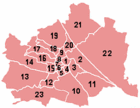- Districts of Vienna
-
The districts of Vienna (German: Bezirke) are 23 named city sections of Vienna, Austria, which are also numbered for easy reference. For centuries, district boundaries have changed. For their creation and administration, see the Districts and Enlargement chapter of the Vienna article.
The seats of Bezirksvorsteher (district head) and Bezirksvertretung (district assembly) are located in the respective district; with the exception of the 14th district, whose political representatives are residing in the 13th district (to which much of the 14th had belonged until 1938). The Magistratisches Bezirksamt (district office of the city administration) in four locations is combining services for two districts:
-
- for the 1st and 8th district in the 1st,
- for the 4th and 5th district in the 5th,
- for the 6th and 7th district in the 7th,
- for the 13th and the 14th district in the 13th.
Hence Vienna has 19 district offices.
Since 2002, in Austria, instead of the police the mayors are responsible for objects found in public places. In Vienna, the mayor has ordered the district offices to perform the functions police stations have performed until then. Since 2005, by federal law the district offices are responsible for issuing passports and registering residents, tasks until then covered in Vienna by the Federal Police.
Optimizing overhead costs has gone farther with the Federal Police of Vienna. The 23 District Police Commands in 2002 have been reduced to 14 City Police Commands. Reducing the number of small districts by mergers, as they have happened in Berlin after the 1990 reunification of Germany, have not even been discussed in Vienna.
Contents
District locations
The following are locations of the 23 districts:
- Innere Stadt (city centre, many functions, few residents)
- Leopoldstadt (on the island between Danube and Danube Canal, with Praterstern, Vienna's most frequented traffic spot, and Giant Wheel)
- Landstraße (on the right bank of the Danube Canal, Belvedere Palace)
- Wieden (very small district south of the city centre)
- Margareten (separated from Wieden in 1861)
- Mariahilf (small district on main shopping lane leading to Westbahnhof)
- Neubau (small district on main shopping lane leading to Westbahnhof, with MuseumsQuartier, large cultural complex)
- Josefstadt (small district very close to City Hall, Parliament and University)
- Alsergrund (General Hospital district)
- Favoriten (in the south of Vienna, largest district in population, building site of new main train station)
- Simmering (on the right bank of the Danube Canal, Central Cemetery)
- Meidling (on the southern bank of the Wien river)
- Hietzing (on the southern bank of the Wien river, Schönbrunn Palace)
- Penzing (on the northern bank of the Wien river, separated from Hietzing in 1938, Otto Wagner's Church Am Steinhof)
- Rudolfsheim-Fünfhaus (on the northern bank of the Wien river; until 1938, 14th and 15th district, Westbahnhof)
- Ottakring (on the western outskirts, Vienna's traditional brewery)
- Hernals (on the northwestern outskirts)
- Währing (on the northwestern outskirts, Central Institute of Meteorology)
- Döbling (on the northern outskirts, the classical ‘Heurigen’ district)
- Brigittenau (separated from Leopoldstadt in 1900)
- Floridsdorf (on the left bank of the Danube, industry areas, northernmost part of Vienna)
- Donaustadt (on the left bank of the Danube, largest district in size, UN City, largest convention hall)
- Liesing (southernmost district, industry areas)
By looking at the postal code it can be determined in which district a given address is located; 1XXA - 1 denotes Vienna, XX the district number (if it is a single digit then with a leading zero), A is the number of the post office (irrelevant in this case, usually zero). Example: 1070 for Neubau. Exceptions of that are 1300 for the Vienna International Airport located in Lower Austria near Schwechat, 1400 for the UN Complex, 1450 for the Austria Center Vienna, and 1500 for the Austrian UN-Forces.
The numbering of the districts reflects to some degree when they were incorporated into Vienna.
- The first district comprises Vienna's historic centre and used to be the entire city until 1850.
- Districts 2-9 (and 20 which was in 1900 separated from the second district) are known as Innenbezirke (inner districts) and composed of the former Vorstädte, which were located inside the Linienwall, the second ring of fortifications around Vienna. Those districts are located within the Gürtel today.
- The other districts are known as Außenbezirke (outer districts) and are the former Vororte.
District populations
The following are current district populations, as of 2011-01-01 (source [1]):
-
District Population[1] 1. Innere Stadt 16,854 2. Leopoldstadt 96,016 3. Landstraße 85,045 4. Wieden 30,943 5. Margareten 53,178 6. Mariahilf 29,623 7. Neubau 30,392 8. Josefstadt 23,747 9. Alsergrund 39,688 10. Favoriten 177,215 11. Simmering 90,712 12. Meidling 88,579
District Population 13. Hietzing 51,292 14. Penzing 84,933 15. Rudolfsheim-Fünfhaus 72,021 16. Ottakring 95,386 17. Hernals 52,913 18. Währing 48,013 19. Döbling 68,820 20. Brigittenau 83,607 21. Floridsdorf 142,603 22. Donaustadt 158,933 23. Liesing 93,629 See also
References
- ^ a b "Statistik Austria – Bevölkerung zu Jahresbeginn seit 2002 nach Politischen Bezirken", Statistik Austria.
External links
 Media related to Districts of Vienna at Wikimedia Commons
Media related to Districts of Vienna at Wikimedia CommonsDistricts of Vienna Districts
by
NumberI. Innere Stadt · II. Leopoldstadt · III. Landstraße · IV. Wieden · V. Margareten · VI. Mariahilf ·VII. Neubau · VIII.Josefstadt · IX.Alsergrund · X. Favoriten · XI. Simmering · XII. Meidling · XIII. Hietzing · XIV. Penzing · XV. Rudolfsheim-Fünfhaus · XVI. Ottakring · XVII. Hernals · XVIII. Währing · XIX. Döbling · XX. Brigittenau · XXI. Floridsdorf · XXII. Donaustadt · XXIII. Liesing Categories:
Categories: -
Wikimedia Foundation. 2010.

